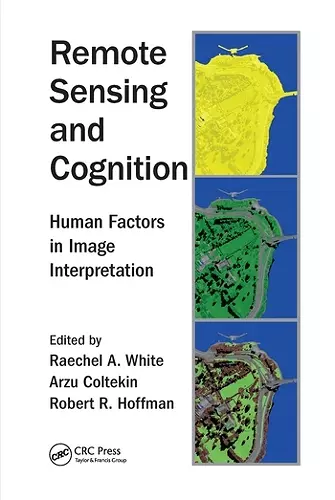Remote Sensing and Cognition
Human Factors in Image Interpretation
Robert R Hoffman editor Raechel A White editor Arzu Coltekin editor
Format:Paperback
Publisher:Taylor & Francis Ltd
Published:30th Jun '20
Currently unavailable, and unfortunately no date known when it will be back
This paperback is available in another edition too:
- Hardback£185.00(9781498781565)

Human factors play a critical role in the design and interpretation of remotely sensed imagery for all Earth sciences. Remote Sensing and Cognition: Human Factors in Image Interpretationbrings together current topics widely recognized and addressed regarding human cognition in geographic imagery, especially remote sensing imagery with complex data. It addresses themes around expertise including methods for knowledge elicitation and modeling of expertise, the effects of different aspects of realism on the interpretation of the environment, spatial learning using imagery, the effect of visual perspective on interpretation, and a variety of technologies and methods for utilizing knowledge in the analysis of remote sensing imagery.
Written by leaders in the field, this book provides answers to the host of questions raised at the nexus of psychology and remote sensing. Academics and researchers with an interest in the human issues surrounding the use of remote sensing data will find this book to be an invaluable resource. The topics covered in this book are useful for both the scientific analysis of remote sensing imagery as well as the design and display of remote sensing imagery to facilitate a variety of other tasks including education and wayfinding.
Features
- Brings together remote sensing, environmental, and computer scientists discussing their work from a psychological or human factors perspective
- Answers questions related to aesthetics of scientific visualization and mathematical analysis of perceptible objects
- Explains the perception and interpretation of realistic representations
- Provides illustrative real-world examples
- Shows how the features of display symbols, elements, and patterns have clear effects on processes of perception and visual search
"Almost two decades have passed since the initial foray into the intersection of psychology and remote sensing. And so, our community of like-minded researchers will no doubt welcome the arrival of this latest endeavor. Much has changed since then, not only in our ability to gather geospatial data, but also to access it and extract actionable information. However, performing this task (sense-making) in an accurate and efficient manner requires awareness of, and careful attention to, not only the technologies required, but the human factors that are inextricably involved as well. This update and expansion on the prior work will help both the seasoned researcher (as a go to reference), as well as the newcomer (as required reading), through the breadth and depth of insights provided within a single, cohesive work."
—Paul Pope, Space & Remote Sensing group, Los Alamos National Laboratory, USA
"Since collaborating with Dr. Hoffman (and others) on the earlier version of this book, the science behind human acquisition of spatial knowledge has advanced greatly. And a second examination of these advances (not merely an update, but a companion volume) ensures that the scientific timeline (due to both advancing science and technology) is retained. This volume also adds two important features. First, it stretches across a myriad of disciplines involving such knowledge acquisition and, second, it treats the topic globally.
For anyone who uses geospatial information (or anyone who wants to), this book can serve as an invaluable background resource. It’s worth the read!"
— H. Michael Mogil, Certified Consulting Meteorologist
"We are here treated with an update to the classic The Interpretation of Remote Sensing Imagery: The Human Factor. As with the Editors themselves, the area has ‘moved on’ substantively since the turn of the century. Now here, in its many elaborated forms, is a maturing science that cries out for reappraisal and reinterpretation and this text provides it in spades. Assembling a stellar line of contributors, the present Editors have done a marvelous job of illustrating the involving intellectual evolution of the burgeoning human science based on geospatial analyses. As with its progenitor, I anticipate that this also will become a classic of our times."
—Peter Hancock, University of Central Florida, USA
ISBN: 9780367571788
Dimensions: unknown
Weight: 453g
176 pages